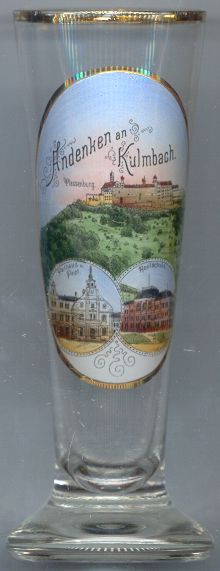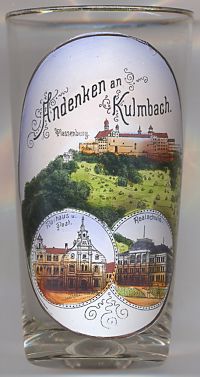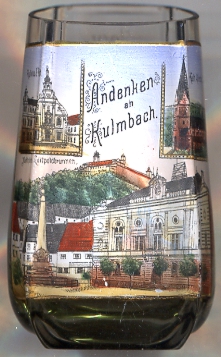

|
| DEUTSCHLAND | GERMANY |
| Bundesland: Freistaat Bayern | Bavaria |
| Regierungsbezirk: Oberfranken | |
| Landkreis: Kulmbach |
Kulmbach is situated at an elevation of 346 m on the river Weißer Main in the administrative region Oberfranken (Upper Franconia) of Bavaria.
The place was first mentioned as Kulma in a document of 1035 confirming the bestowal upon the bishops of Bamberg.
In 1057 it came in possession of the Counts of Andechs (later Dukes of Andechs-Meranien). Upon their extinction
In 1243 it passed to the Thuringian Counts of Orlamünde, and finally, in 1340, it was inherited by the Burgraves of Nuremberg
of the Hohenzollern dynasty. The territories of the burgraves were divided in 1397/98 and Kulmbach became the residence of the northern part
(Ansbach became the residence of the other line). A flourishing period for both Kulmbach and Ansbach began when Friedrich VI of Ansbach
obtained the margraviate of Brandenburg in 1415 (Elector Friedrich I). In 1526 Margrave Georg (called 'the Pious') of Brandenburg-Anbach and Kulmbach introduced the Reformation
in his countries. This caused continuing opposition between the two Hohenzollern margraviates and the neighbouring catholic sovereign bishoprics
of Bamberg and Würzburg, and for centuries influnced the historical events of the whole region.
 During the Second Margrave's War, Margrave Albrecht Alcibiades of Brandenburg-Kulmbach was defeated in 1553.
During the siege of the Plassenburg (see below), the defenders of the castle set the town on fire to prevent that the aggressors would have shelter
during the winter. Nevertheless, the castle had to surrender in the following year. Kulmbach was rebuilt in a splendid manner
by Margrave Georg Friedrich of Brandenburg-Ansbach who had succeeded his uncle Albrecht Alcibiades in Kulmbach.
When the Franconian lines of the Hohenzollern became extinct in 1603, Brandenburg-Ansbach and Brandenburg-Kulmbach were
inherited by two younger sons of Elector Johann Georg of Brandenburg, Joachim Ernst (Ansbach) and Christian (Kulmbach).
Margrave Christian then transferred the residence to Bayreuth in 1604.
The loss of its status of a residence town caused a definite decline of the importance of Kulmbach. Only during the Thirty Years' War (1618–1648)
the Plassenburg was used several times as a temporary residence. In 1769 Brandenburg-Bayreuth was finally inherited by Brandenburg-Ansbach.
The last margrave, Christian Friedrich Carl Alexander, abdicated in 1791 in favour of Friedrich Wilhelm II, King in Prussia.
During the Napoleonic Wars Kulmbach was occupied by French and Bavarian troops in 1806. After the Peace of
Tilsit in 1807 it became part of France, but after the defeat of Napoleon
and the Peace of Paris it became part of the Kingdom of Bavaria in 1810. Throughout the following decades Kulmbach ermained a small provincial town.
The industrialisation only began when Kulmbach was connected to the Bavarian railroad system in 1846.
During the Second Margrave's War, Margrave Albrecht Alcibiades of Brandenburg-Kulmbach was defeated in 1553.
During the siege of the Plassenburg (see below), the defenders of the castle set the town on fire to prevent that the aggressors would have shelter
during the winter. Nevertheless, the castle had to surrender in the following year. Kulmbach was rebuilt in a splendid manner
by Margrave Georg Friedrich of Brandenburg-Ansbach who had succeeded his uncle Albrecht Alcibiades in Kulmbach.
When the Franconian lines of the Hohenzollern became extinct in 1603, Brandenburg-Ansbach and Brandenburg-Kulmbach were
inherited by two younger sons of Elector Johann Georg of Brandenburg, Joachim Ernst (Ansbach) and Christian (Kulmbach).
Margrave Christian then transferred the residence to Bayreuth in 1604.
The loss of its status of a residence town caused a definite decline of the importance of Kulmbach. Only during the Thirty Years' War (1618–1648)
the Plassenburg was used several times as a temporary residence. In 1769 Brandenburg-Bayreuth was finally inherited by Brandenburg-Ansbach.
The last margrave, Christian Friedrich Carl Alexander, abdicated in 1791 in favour of Friedrich Wilhelm II, King in Prussia.
During the Napoleonic Wars Kulmbach was occupied by French and Bavarian troops in 1806. After the Peace of
Tilsit in 1807 it became part of France, but after the defeat of Napoleon
and the Peace of Paris it became part of the Kingdom of Bavaria in 1810. Throughout the following decades Kulmbach ermained a small provincial town.
The industrialisation only began when Kulmbach was connected to the Bavarian railroad system in 1846.

The  Plassenburg [top picture] is situated on a limestone rock high above the city of Kulmbach.
The castle was founded in the 11th century by the counts of Andechs. The first mention in a document
dates from 1135. When the Hohenzollern burgraves of Nuremberg had inherited Kulmbach in 1340,
the Plassenburg became their residence in 1397. After the surrender of the castle during the First Margrave's War in 1554, the castle
was largely destroyed, even its wells were contaminated. The Plassenburg was then rebuilt as a residence by Margrave Georg Friedrich.
After the residence was moved to Bayreuth in 1604, the Plassenburg mainly served as a defense fortress.
The fortress was so strong that it did not suffer any damages during the Thirty Years' War. The fortifications were further extended during the
17th and 18th centuries, but were partly torn down after Kulmbach had been occupied by French troops in 1806.
After 1810 the castle was used as a Bavarian state prison until after the end of World War I.
In 1929 extensive restoration works began. Today, the Plassenburg is again one of the most impressive castles in Bavaria.
Plassenburg [top picture] is situated on a limestone rock high above the city of Kulmbach.
The castle was founded in the 11th century by the counts of Andechs. The first mention in a document
dates from 1135. When the Hohenzollern burgraves of Nuremberg had inherited Kulmbach in 1340,
the Plassenburg became their residence in 1397. After the surrender of the castle during the First Margrave's War in 1554, the castle
was largely destroyed, even its wells were contaminated. The Plassenburg was then rebuilt as a residence by Margrave Georg Friedrich.
After the residence was moved to Bayreuth in 1604, the Plassenburg mainly served as a defense fortress.
The fortress was so strong that it did not suffer any damages during the Thirty Years' War. The fortifications were further extended during the
17th and 18th centuries, but were partly torn down after Kulmbach had been occupied by French troops in 1806.
After 1810 the castle was used as a Bavarian state prison until after the end of World War I.
In 1929 extensive restoration works began. Today, the Plassenburg is again one of the most impressive castles in Bavaria.
The  Town Hall [bottom left] was built in the 16th century.
The impressive Rococo façade was created in 1752 by the court architect Joseph Saint-Pierre.
Town Hall [bottom left] was built in the 16th century.
The impressive Rococo façade was created in 1752 by the court architect Joseph Saint-Pierre.
The  Realschule (secondary school) [bottom right]
was built in 1892–1893. Since 1962 the representative building serves as the main building
of the Markgraf-Georg-Friedrich-Gymnasium (comprehensive secondary or grammar school).
Realschule (secondary school) [bottom right]
was built in 1892–1893. Since 1962 the representative building serves as the main building
of the Markgraf-Georg-Friedrich-Gymnasium (comprehensive secondary or grammar school).

The  Catholic parish church Zu Unser Lieben Frau (Lady Church) [left, no. 2752: top right picture]
was built in 1894 by the architect Bruno Specht in Gothic revival style.
Catholic parish church Zu Unser Lieben Frau (Lady Church) [left, no. 2752: top right picture]
was built in 1894 by the architect Bruno Specht in Gothic revival style.
The  Luitpoldbrunnen (Luitpold fountain) [left, no. 2752: bottom left]
was built in 1898 according to a design of the architect Martin Düfler. The sculptures were made by Eduard Beyrer.
Luitpoldbrunnen (Luitpold fountain) [left, no. 2752: bottom left]
was built in 1898 according to a design of the architect Martin Düfler. The sculptures were made by Eduard Beyrer.
![[scale]](lineal.jpg)